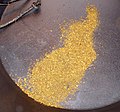File:Gold dust (placer gold) 2 (16849889230).jpg

原始檔案 (3,052 × 2,844 像素,檔案大小:3.78 MB,MIME 類型:image/jpeg)
摘要
| 描述Gold dust (placer gold) 2 (16849889230).jpg |
Gold dust (placer gold) (DRA 101.1, Draper Museum of Natural History, Cody, Wyoming, USA) A mineral is a naturally-occurring, solid, inorganic, crystalline substrance having a fairly definite chemical composition and having fairly definite physical properties. At its simplest, a mineral is a naturally-occurring solid chemical. Currently, there are over 4900 named and described minerals - about 200 of them are common and about 20 of them are very common. Mineral classification is based on anion chemistry. Major categories of minerals are: elements, sulfides, oxides, halides, carbonates, sulfates, phosphates, and silicates. Elements are fundamental substances of matter - matter that is composed of the same types of atoms. At present, 118 elements are known (four of them are still unnamed). Of these, 98 occur naturally on Earth (hydrogen to californium). Most of these occur in rocks & minerals, although some occur in very small, trace amounts. Only some elements occur in their native elemental state as minerals. To find a native element in nature, it must be relatively non-reactive and there must be some concentration process. Metallic, semimetallic (metalloid), and nonmetallic elements are known in their native state as minerals. Gold (Au) is the most prestigious metal known, but it's not the most valuable. Gold is the only metal that has a deep, rich, metallic yellow color. Almost all other metals are silvery-colored. Gold is very rare in crustal rocks - it averages about 5 ppb (parts per billion). Where gold has been concentrated, it occurs as wires, dendritic crystals, twisted sheets, octahedral crystals, and variably-shaped nuggets. It most commonly occurs in hydrothermal quartz veins, disseminated in some contact- & hydrothermal-metamorphic rocks, and in placer deposits. Placers are concentrations of heavy minerals in stream gravels or in cracks on bedrock-floored streams. Gold has a high specific gravity (about 19), so it easily accumulates in placer deposits. Its high density allows prospectors to readily collect placer gold by panning. In addition to its high density, gold has a high melting point (over 1000º C). Gold is also relatively soft - about 2.5 to 3 on the Mohs Hardness Scale. The use of pure gold or high-purity gold in jewelry is not desirable as it easily gets scratched. The addition of other metals to gold to increase the hardness also alters the unique color of gold. Gold jewelry made & sold in America doesn’t have the gorgeous rich color of high-purity gold. The gold dust shown above is placer gold, derived from river or stream sediments. "Gold dust" essentially refers to very small gold nuggets. The provenance of this gold dust is not disclosed on public signage at the museum. However, I suspect it might be from California. The donor of this gold dust is the eccentric millionaire Forrest Fenn, who famously buried a treasure chest in the New Mexico Rocky Mountains. The chest contains a jar of gold dust that he says was from California's mid-1800s gold rush. The gold dust shown above may be a subsample of that material. |
| 日期 | |
| 來源 | Gold dust (placer gold) 2 |
| 作者 | James St. John |
授權條款
- 您可以自由:
- 分享 – 複製、發佈和傳播本作品
- 重新修改 – 創作演繹作品
- 惟需遵照下列條件:
- 姓名標示 – 您必須指名出正確的製作者,和提供授權條款的連結,以及表示是否有對內容上做出變更。您可以用任何合理的方式來行動,但不得以任何方式表明授權條款是對您許可或是由您所使用。
| 這幅圖片原始出處為Flickr的https://www.flickr.com/photos/47445767@N05/16849889230 ,作者為jsj1771 。經機器人FlickreviewR在2015年四月6日審查後確定為採用cc-by-2.0的協議授權使用。 |
2015年四月6日
說明
在此檔案描寫的項目
描繪內容
沒有維基數據項目的某些值
攝影器材 繁體中文 (已轉換拼寫)
檔案來源 Chinese (Taiwan) (已轉換拼寫)
15 8 2010
曝光時間 繁體中文 (已轉換拼寫)
0.01666666666666666666 秒
4.9
18.6 毫米
ISO速度 繁體中文 (已轉換拼寫)
250
檔案歷史
點選日期/時間以檢視該時間的檔案版本。
| 日期/時間 | 縮圖 | 尺寸 | 用戶 | 備註 | |
|---|---|---|---|---|---|
| 目前 | 2015年4月6日 (一) 20:36 |  | 3,052 × 2,844(3.78 MB) | Jacopo Werther | Transferred from Flickr via Flickr2Commons |
檔案用途
下列頁面有用到此檔案:
全域檔案使用狀況
詮釋資料
此檔案中包含擴展的資訊。這些資訊可能是由數位相機或掃描器在建立時或數位化過程中所加入。
如果此檔案的來源檔案已被修改,一些資訊在修改後的檔案中將不能完全反映出來。
| 相機製造商 | Canon |
|---|---|
| 相機型號 | Canon PowerShot D10 |
| 曝光時間 | 1/60 秒 (0.016666666666667) |
| 光圈值 | f/4.9 |
| ISO 速率 | 250 |
| 資料產生的日期時間 | 2010年8月15日 (日) 13:56 |
| 焦距 | 18.6毫米 |
| 影像標題 | |
| 寬度 | 4,000 px |
| 高度 | 3,000 px |
| 每像素位元 |
|
| 像素合成 | RGB |
| 方位 | 標準 |
| 像素數量 | 3 |
| 水平解析度 | 180 dpi |
| 垂直解析度 | 180 dpi |
| 使用軟體 | Adobe Photoshop Elements 13.0 (Macintosh) |
| 檔案修改日期時間 | 2015年4月5日 (日) 00:20 |
| 亮度與彩度位置 | 同時取樣 |
| Exif 版本 | 2.21 |
| 數位化的日期時間 | 2010年8月15日 (日) 13:56 |
| 每像素內含 |
|
| 影像壓縮模式 | 3 |
| APEX 快門速度 | 5.90625 |
| APEX 光圈 | 4.59375 |
| APEX 曝光補償 | 0 |
| 最大陸地光圈 | 4.59375 APEX(f/4.91) |
| 測光模式 | 模式 |
| 閃光燈 | 閃光燈已開啟、自動模式、防紅眼模式 |
| 支援的 Flashpix 版本 | 1 |
| 色彩空間 | sRGB |
| X 軸焦平面解析度 | 16,460.905349794 |
| Y 軸焦平面解析度 | 16,483.516483516 |
| 焦平面解析度單位 | 英寸 |
| 感光模式 | 單晶片彩色區域感測器 |
| 檔案來源 | 數位相機 |
| 自訂影像處理 | 一般程序 |
| 曝光模式 | 自動曝光 |
| 白平衡 | 自動白平衡 |
| 數位變焦比率 | 1 |
| 場景拍攝類型 | 標準 |
| 使用鏡頭 | 6.2-18.6 mm |
| 詮釋資料最後修改日期 | 2015年4月4日 (六) 20:20 |
| 原始文件唯一識別碼 | 76E78045657F31899B664D27CC34D070 |
| IIM 版本 | 17,259 |
